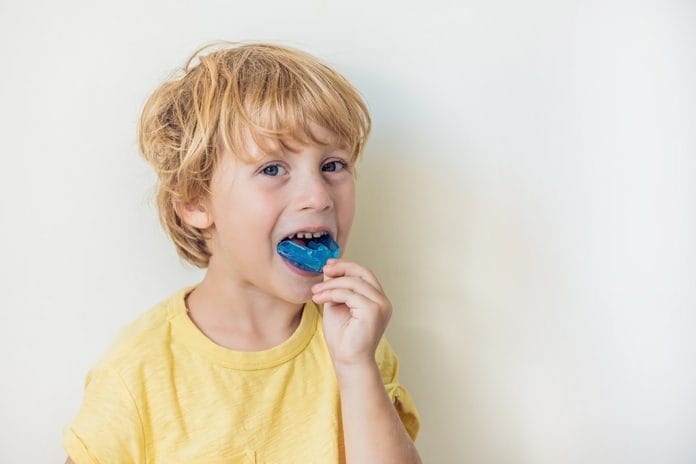It is that time of year when the kids start a new school year, and many participate in school sports programs. Although schools attempt to keep our children safe on and off the field, the regulations for athletic mouth guards are not consistent with the need to prevent injury in the majority of school-based sports. A dental professional has the opportunity to educate parents, children, and coaches, on the benefits of an athletic mouth guard to prevent injury of hard and soft tissue, as well as educate on proper athletic mouth guard maintenance.
An athletic mouthguard is “a protective device for the mouth that covers the teeth and gums to prevent and reduce injury to the teeth, arches, lips, and gums.”1 There are three types of athletic mouth guards available to the public: the ready-made or “stock” guard, the mouth-formed or “boil and bite” guard, and the custom-made athletic mouth guard.2
The advantages of the “stock” athletic mouth guard are it’s availability and reduced cost. However, the disadvantage is the ill-fit that may cause a risk for irritation to the soft tissue. The “boil and bite” athletic mouth guard is also readily available and has a reduced cost. It is formed to fit the individual’s mouth by submerging it in hot water until it becomes soft and then placing it in the mouth to take shape. The disadvantages are it’s cumbersome and not an actual “custom” form fit, which may result in tissue irritation during use. Last, the “custom” athletic mouth guard is a durable material fabricated solely for the individual, and therefore it reduces the risk of tissue injury. The disadvantages are it requires multiple dental office visits for an impression and delivery, and it costs more due to the mouth guard being fabricated in a dental lab.
The American Dental Association (ADA) has provided prevention guidelines for athletic mouth guards since the mid-1990’s.2 The ADA and American National Standards Institute (ANSI) have stated there are no products available commercially which meet criteria set by these organizations to reduce injury.3
The guidelines set by the ADA4 are as follows:
- Safe to use in mouth and do not cause harm or irritation of soft tissue.
- Low to no risk of injury to hard or soft tissue or damage to the appliance.
- Free of sharp or jagged edges.
- Passes testing outlined by the ADA and ANSI for hardness, resistance to tearing upon impact, and measurement of the amount of water absorbed.
Sports-related dental injuries constitute 13-39% of all dental injuries.5 Examples of sports-related dental injuries are tooth avulsion, soft tissue injury, tooth fracture or displacement, and jaw fracture or displacement. These incidents typically affect males over females, and the maxillary incisor is the most commonly injured tooth.
A study performed in 1996-1997 of Minnesota High School athletes reported athletes with fixed orthodontics were at a higher risk for dental injury. The study also concluded 10% of the test subjects sustained some form of dental injury and 6% reported not using an athletic mouth guard. Soccer reported the highest incident of injuries, wrestling came in at second for dental injuries, and basketball trailed behind at third.6
The statistics are alarming, considering most schools only require athletic mouth guards be used in “contact” sports. However, the ADA has indicated not only are players at risk for dental injuries in contact sports, such as boxing and football, but they are also at risk in non-contact sports, such as ice skating and gymnastics. Yet, the National Federation of State High School Association (NFHS) and the Sports Medicine Advisory Committee (SMAC) only mandates “the use of mouth guards in football, field hockey, ice hockey, lacrosse, and wrestling (for wrestlers wearing braces).”7
This poses the question, why are we limiting our requirements for athletic mouth guard use to football, lacrosse, field hockey, ice hockey, and wrestling, when our children pose a risk for dental injuries in non-contact sports, such as gymnastics, baseball, basketball, and soccer?
During my time in dental hygiene school, I witnessed an athlete in a non-contact sport receive a dental injury. Along with four of my classmates, I attended a college basketball game, during which, a male player leaped out of bounds to save a ball and collided with a female cheerleader. The collision caused the cheerleader to land face-first into folded-up bleachers, which resulted in tooth avulsion. As dental hygiene students, we kicked into gear, found the tooth, placed it in the milk we quickly got from a vending machine and gave it to the EMT.
Unfortunately, the tooth was unable to be replanted in the socket due to a maxillary fracture at the sight of the trauma. However, the cheerleader eventually was able to have an implant placed where her central incisor was lost during the accident. This is an excellent example of how an athletic mouth guard, in this case, to be worn by the cheerleader, may have prevented a tooth and jaw injury during non-contact sports play.
Dental hygienists also have the opportunity to educate parents and players about the importance of athletic mouth guard care and maintenance. The ADA has recommended certain criteria for the care and maintenance of a mouth guard to reduce the incident of product failure and bacterial infection. The recommendations by the ADA2 are as follows:
- Rinse before and after use with toothpaste and toothbrush.
- Clean in cool soapy water and rinse.
- Transport in a ventilated container.
- Check for wear.
- Keep out of the sun and hot water.
The care and maintenance of an athletic mouth guard are important to reduce bacterial formation and to keep the integrity of the product intact. A study of sixty-two football players indicated the presence of four different types of bacteria, as well as yeast and mold, formation on athletic mouth guards after use. The most common bacteria found was gram-positive cocci, specifically Staphylococcus ssp and Micrococcus ssp. This study indicates microorganisms can form without proper care of the athletic mouth guard and can increase the incidence of oral or systemic disease.8
Although the requirements of athletic mouth guards in schools and recreational sports are inconsistent with the importance of dental injury prevention, as dental hygienists, we have the means to educate parents, coaches, and players, of their necessity. The presence of athletic mouth guard use during any sport with the potential for facial injury can reduce the potential of tooth loss, dental injury, and abundant monetary cost which may occur due to the injury. The proper care, maintenance, and type of athletic mouth guard are also important aspects of dental trauma prevention.
SEE ALSO: Science Confirms Water Fluoridation Prevents Tooth Decay in Children
DON’T MISS: Why Dental Hygienists Should be Employed in Every School
References
- Definition of Athletic Mouth Guard. Retrieved from www.wikipedia.com
- www.ADA.org
- Gould TE, Piland SG, Shinj., Hoyle CE, Zazarenko S. (2009). Characterization of mouthguard materials: physical and mechanical properties of commercialized products. Dent Material 2009; 25 (6): 771-80. Retrieved from: https://www.ncbi.nlm.nih.gov/pubmed/19195697
- ANSI/ADA Standard No 99-2001 (R2013) Athletic mouth protectors and materials. Chicago: ADA. Retrieved from: http://ebusiness.ada.org/productcatalog/1832/Prosthodontic-Materials/ANSIADA-Standard-No-99-Athletic-Mouth-Protectors-and-Materia/ADA99-2001
- Mischkowski RA, Slessegger M, Zoeller JE. (1999). Mouth guard protection for prevention of athletic injuries to teeth, mouth and jaw. Sept; 13(#):65-7. Retrieved from: https://www.ncbi.nlm.nih.gov/pubmed/10609289
- Kvitlem B., Hardu NA., Roettger M., Conry J. (1998). Incident of oralfacial injuries in high school sports. J Pub Health Dept. 1998 Fall; 5814:288-93.
- Position statement and Recommendations for mouthguard use in sports. Retrieved from: https://www.nfhs.org/media/1014750/mouthguard-nfhs-smac-position-statement-october-2014.pdf
- Richard T. Glass, Robert S. Conrad, Gerwald A. Kohler, Aric J. Warren, James W. Bullard (2011). Microbiota found in protective athletic mouthguards. Retrieved from: https://journals.sagepub.com/doi/abs/10.1177/1941738111404869











